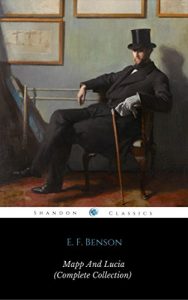Mapp and Lucia is a collective name for a series of novels by E. F. Benson which features humorous incidents in the lives of (mainly) upper-middle-class British people in the 1920s and 1930s, vying for social prestige and one-upmanship in an atmosphere of extreme cultural snobbery. Several of them are set in the small seaside town of Tilling, closely based on Rye, East Sussex, where Benson lived for a number of years and (like Lucia) served as mayor. Lucia previously lived at Riseholme, based on Broadway, Worcestershire, from where she brought to Tilling her celebrated recipe for Lobster à la Riseholme.
"Mallards", the home of Miss Mapp—and subsequently Lucia—was based on Lamb House in Rye. The house had previously been lived in by Henry James and had a garden room overlooking the street (unfortunately a German bomb destroyed the Garden Room in World War II. The rest of the house is now a National Trust property.)
The novels, in chronological order, are:
Queen Lucia (1920)
Miss Mapp (1922)
Lucia in London (1927)
Mapp and Lucia (1931)
Lucia's Progress (1935) (published in the U.S. as The Worshipful Lucia)
Trouble for Lucia (1939)
The first three books concern only the protagonist named in the title; the last three feature both Mapp and Lucia.
In 1977 Thomas Y. Cromwell Company reprinted all six novels in a compendium called Make Way for Lucia. The order of Miss Mapp and Lucia in London was switched in the compendium, and a Miss Mapp short story called "The Male Impersonator" was included between Miss Mapp and Mapp and Lucia.
"Desirable Residences", one further short story featuring Miss Mapp, and previously having seen only one magazine printing in Benson's own time, was discovered by Jack Adrian in the 1990s and included in his collection of Benson stories, Desirable Residences. A slight oddity about this very short piece, is that the town of Tilling was called Tillingham in the original printing, according to Jack Adrian's introduction to his collection. The characters of Miss Mapp and Diva Plaistow are clearly recognizable, however, as are their desirable residences. Miss Mapp, for example here lives in "Mallards", the fictional Lamb House that was always the Queen Castle vied for by Mapp and Lucia.
The character Susan Leg, appearing briefly in Trouble for Lucia, first appeared as a major character in Benson's novel Secret Lives (1932), which is similar in style to the Mapp and Lucia books.
"Mallards", the home of Miss Mapp—and subsequently Lucia—was based on Lamb House in Rye. The house had previously been lived in by Henry James and had a garden room overlooking the street (unfortunately a German bomb destroyed the Garden Room in World War II. The rest of the house is now a National Trust property.)
The novels, in chronological order, are:
Queen Lucia (1920)
Miss Mapp (1922)
Lucia in London (1927)
Mapp and Lucia (1931)
Lucia's Progress (1935) (published in the U.S. as The Worshipful Lucia)
Trouble for Lucia (1939)
The first three books concern only the protagonist named in the title; the last three feature both Mapp and Lucia.
In 1977 Thomas Y. Cromwell Company reprinted all six novels in a compendium called Make Way for Lucia. The order of Miss Mapp and Lucia in London was switched in the compendium, and a Miss Mapp short story called "The Male Impersonator" was included between Miss Mapp and Mapp and Lucia.
"Desirable Residences", one further short story featuring Miss Mapp, and previously having seen only one magazine printing in Benson's own time, was discovered by Jack Adrian in the 1990s and included in his collection of Benson stories, Desirable Residences. A slight oddity about this very short piece, is that the town of Tilling was called Tillingham in the original printing, according to Jack Adrian's introduction to his collection. The characters of Miss Mapp and Diva Plaistow are clearly recognizable, however, as are their desirable residences. Miss Mapp, for example here lives in "Mallards", the fictional Lamb House that was always the Queen Castle vied for by Mapp and Lucia.
The character Susan Leg, appearing briefly in Trouble for Lucia, first appeared as a major character in Benson's novel Secret Lives (1932), which is similar in style to the Mapp and Lucia books.






